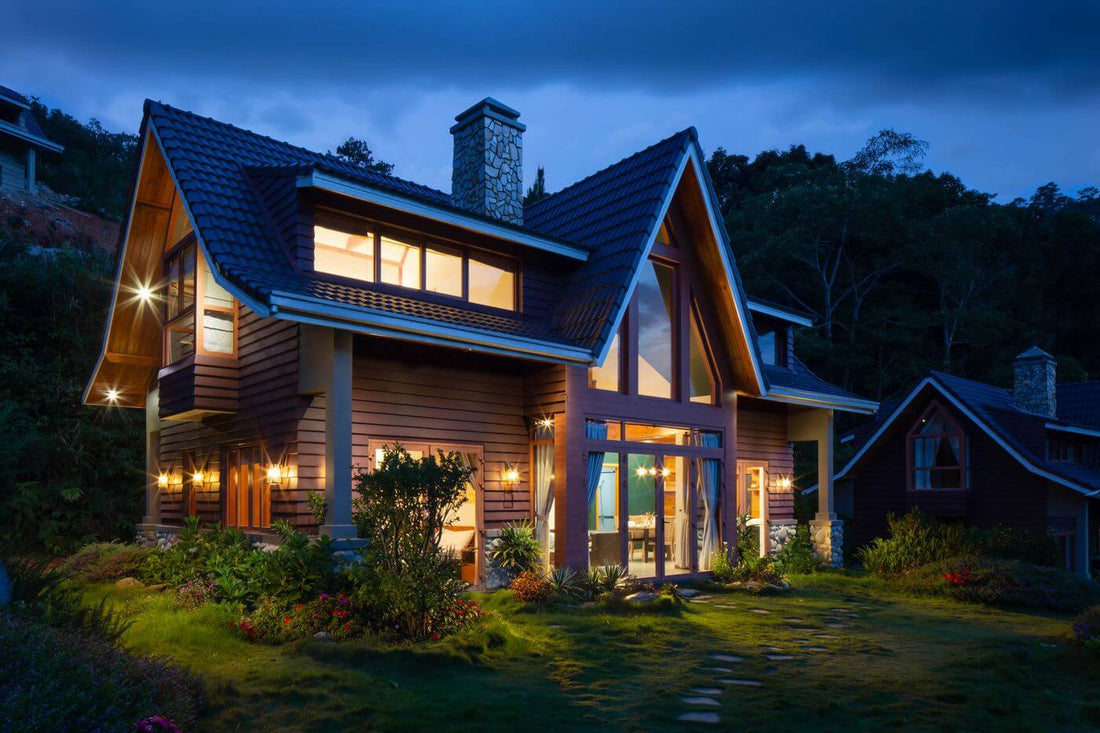Over the last few years, passive solutions to heating and cooling have become increasingly popular. A homeowner can passively heat and cool their house by leveraging its surroundings, building materials, layout, furniture and even decor.
By reducing unwanted solar heat without consuming energy, passive heating and cooling solutions save homeowners money on their utility bills and reduce their carbon footprints. Some of these solutions are incorporated during the design and construction phase, while others are implemented long after the home is built.
Between 25 and 30% of our homes’ heat and air conditioning is lost through our windows. Improving insulation, replacing single-pane glass and sealing any gaps can go a long way to boosting the energy efficiency of your home.
Unfortunately, the average window replacement costs hundreds of dollars and installing insulation can cost thousands. Thankfully, by adding window treatments to your home, you can save on energy bills, keep your home a comfortable temperature year-round, and reduce your carbon footprint – all without overspending.
In this post, we explain how smart blinds help with passive heating and cooling. Follow below for our guide to passive heating and cooling with smart blinds!
Terms to Know
Building Envelope

Your home’s building envelope is made up of construction materials that separate the indoors from the outdoors, such as the roof, wall assembly, foundation, doors and windows. Bethel Afework et al. elaborate in a resource for the University of Calgary: the building envelope protects a home’s interior from environmental effects “like precipitation, wind, temperature, humidity, and ultraviolet radiation.”
In some cases, the building envelope is specifically designed to resist damage from natural disasters like wildfires, hurricanes or floods. In a passive house, the building envelope is designed to maximize energy efficiency.
Passive House

A “passive house” is a building that leverages its site, landscaping and architectural design to maximize natural energy efficiency. Passive design limits consumption and reduces the home’s overall carbon footprint. According to New York Passive House, a passive house is “a very well insulated, virtually airtight building.”
Passive houses are “primarily heated by passive solar gains and internal heat gains from occupants.” The main goal of passive house architects is to approach or achieve net zero energy consumption.
Passive Heating and Cooling

Homeowners can control the temperature in their homes actively or passively. Active heating and cooling is achieved through the use of an expensive solar generator, HVAC system or individual units like fans and space heaters. Passive heating and cooling is more natural and typically less expensive.
In his article “Passive House and Passive Solar: Free Heat for Homes” for EcoHome, Mike Reynolds explains how passive heating works: “passive heating and cooling in homes” is a two-fold endeavor. First, you must determine “where the sun exposure is.” Second, you must try “to capture as much of that heat as you can in the winter while keeping it out in the summer.”
Passive house architects help occupants stay cool during the summer and warm during the winter in a number of ways. First, they decide where on the site the home should be located. The home’s orientation – e.g. whether the kitchen faces north or south – helps control solar heat gain and improve ventilation. Next, they choose the best windows and shading for the home. Finally, they properly insulate the home’s building envelope. Each of these design choices helps passively heat and cool the home.
According to this resource from SmarterHomes.org, “passive heating is by far the most environmentally friendly way to heat your home.” Best of all, any home can benefit from passive heating and cooling - even if it was not designed as a passive house.
As the SmarterHomes resource notes, “passive heating can be improved in an existing home without making major alterations.” Adding energy efficient blinds and other energy efficient window coverings is just one way to passively heat and cool your home.
Solar Gain

“Solar gain” refers to how much an object’s temperature increases when it absorbs heat from the sun. The heated object then transfers solar radiation to surrounding objects and/or empty space.
In his article “How to Heat and Cool Your Home Without Electricity” for the Permaculture Research Institute, Neal Gist explains that this increase in temperature is impacted by the time of day during which natural light exposure occurs. It is also impacted by “the strength of the radiation, and the thermal conductivity of the substance in contact.”
In a 2009 research paper for the ASHRAE, Nathan A. Kotey et al. note solar gain can overheat homes when they are built in the wrong location or orientation. Kotey and colleagues write that “solar gain is…generally the largest and most variable heat gain the building will experience.”
Residential architects who consider the sun when designing homes can help prevent chill during the winter and overheating during the summer. With the right approach, homeowners can leverage solar heat gain to control heat loss during the winter and heat gain during the summer.
How Much Heat is Lost and Gained Through Windows?

A large amount of energy is lost through windows that are poorly sealed, glazed or covered. According to “Improving Window Energy Efficiency” from Natural Resources Canada, “windows can account for up to 25 percent of total house heat loss.”
The US DOE resource “Energy Efficient Window Coverings” estimates 30% of the average home’s heating energy is lost through poorly sealed and covered windows. According to the US Department of Energy, “about 76% of sunlight that falls on standard double-pane windows enters to become heat” in cooling seasons.
The DOE recommends adding multiple window treatments to “help with this energy loss and lower energy bills.” These include adjustable or retractable awnings, roller shades, cellular shades, fabric window shades, drapes and blinds. Smart window coverings operated remotely via a tablet or phone are especially helpful because they allow you to maximize natural light on cold days and reduce natural light on hot days. To make windows even more efficient, the DOE suggests installing “storm windows with low-e coatings and/or multi-layer glazing.”
Both are fairly effective at “improving thermal performance of windows and reducing solar heat gain.” Window treatments, coatings, triple-pane glazing and weather stripping all prevent hot air from entering, cold air from escaping and vice versa. These methods of natural heat control can help keep energy costs down.
Here’s How Much Smart Blinds Help with Passive Heating and Cooling

When installed properly, both exterior and interior blinds help insulate your home – allowing it to passively heat during the winter and cool during the summer. Window blinds also direct sunlight throughout your home, taking advantage of the sun’s warmth and illumination.
But how much do blinds and other window treatments actually help?
Referencing DOE data in her article “Block the Sun and Lower Your Energy Costs With Window Coverings” for Consumer Reports, Mary Farrel answers that “the smart management of window coverings can reduce heat gain [during the summer] by up to 77 percent.” Laura Bourland elaborates in her article “Automated Smart Window Shades Save Energy” for Rise: another study found homeowners “can reduce heat loss by as much as 17%” – just by closing window treatments at night.
Statistics on Smart Blinds and Temperature Control
By themselves, blinds can help homeowners direct and control heat and light from the sun. In their paper “The thermal performance of window coverings” for the Open Journal of Energy Efficiency, Richard Fitton et al. explain. Fitton and his colleagues write that “kitchen and bathroom blinds resulted in savings of 12 and 29%.”
According to the Housing Fact Sheet “Energy Saving Window Treatments” from the Cornell Cooperative Extension of Chemung County, blinds also help with heat loss. Their study found that Venetian blinds alone provide a 6-7% reduction in heat loss during the winter. Smart blinds and highly reflective blinds can deliver even greater results.
The resource “Saving energy with window coverings” from Canadian Contractor explains how. Automated smart blinds “enable you to respond to different temperature changes throughout the day” without staying home to open and close window coverings. Tennessee-based home warranty company American Home Shield notes that reflective blinds can reduce total solar gain by up to 45%. The effects of both smart blinds and reflective blinds are optimized when combined with drapery and other treatments to cover a window completely.
How Homeowners Can Use Smart Blinds to Reduce Solar Heat Gain and Loss

Homeowners can use window blinds and other operable window treatments to reduce solar heat gain and loss by mounting them on south-facing windows and west-facing windows. They can also benefit from passive temperature control by raising, lowering, opening and closing blinds throughout the day. According to the DOE resource “Energy Efficient Window Coverings,” as many as “75% of residential window coverings remain in the same position every day.” However, strategic adjustments can make an enormous difference.
Automating your window blinds is a great way to control heat gain and loss without staying home to manage window treatments manually. The DOE notes that some tightly installed cellular shades and blinds “include the option of automation.” Automation allows the blinds “to open and close on a set schedule.” According to the DOE, this schedule “can be seasonally optimized to reduce heating and cooling loads while maximizing natural light and home comfort.”
Window blinds might be preferable to roman shades, solar shades and other fabric window coverings. This is because “you can adjust the slats to control glare, light, and solar heat gain.” As noted above, homeowners with layered window coverings experience the best results.
When to Open and Close Your Blinds

Homeowners should close their blinds on days when the summer heat is beating down on the house. In her article “Can You Save Energy by Turning Your Blinds Down?” for Hunker, Cora Wilder notes that by closing blinds on these days, you are blocking sunlight from your home. At the same time, you “reduce unwanted solar heat gain.”
If you need natural sunlight to illuminate your home’s interior, consider opening the horizontal slats of your blinds and directing light upwards. When directed toward ceilings with light-colored paint, sunlight illuminates the room without heating it up. This keeps each space cool and bright without using the air conditioner, energy-intensive fans or artificial light sources.
Homeowners should also close their blinds at night during colder months because heat is lost through windows that were poorly sealed or inadequately glazed. According to Wilder, “closing the blinds adds some insulation to the windows, reducing heat loss during cold periods.” Alternatively, homeowners can open blinds, curtains and drapes on summer evenings to let cool air enter and hot air escape.
Other Ways to Reduce Energy Costs Through Passive Temperature Control

The right window treatments can substantially reduce heat gain during the summer and heat loss during the winter. This saves you money by limiting your energy consumption. Automated blinds and blackout curtains can deliver amazing results.
However, adding energy efficient window treatments is not the only way to passively heat and cool your home. Weather-stripping window sills and door jambs is another great way to keep your home warm during the winter and cool during the summer. According to Laura Isaacson in an article for TheEcoGuide.org, “you can save 5-10% on your energy bill…with weather-stripping and caulking.” Blocking your chimney and barricading the fireplace when not in use can also keep warm air from escaping. Additionally, moving furniture to improve air flow can help cool your home during the summer, and placing rugs on the floor can help insulate your home during the winter.
In short, there are dozens of ways to keep your home comfortable all year round without incurring an enormous energy bill.

